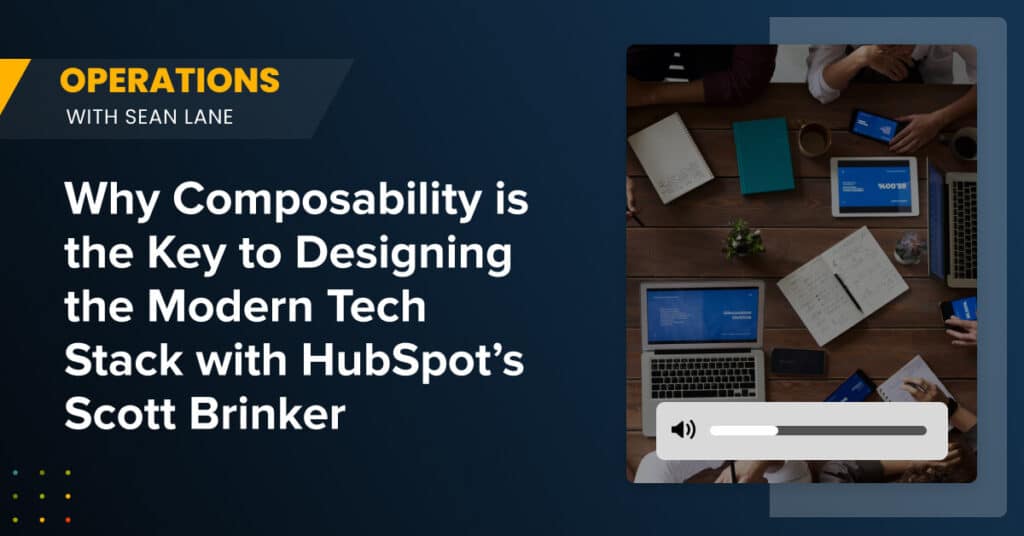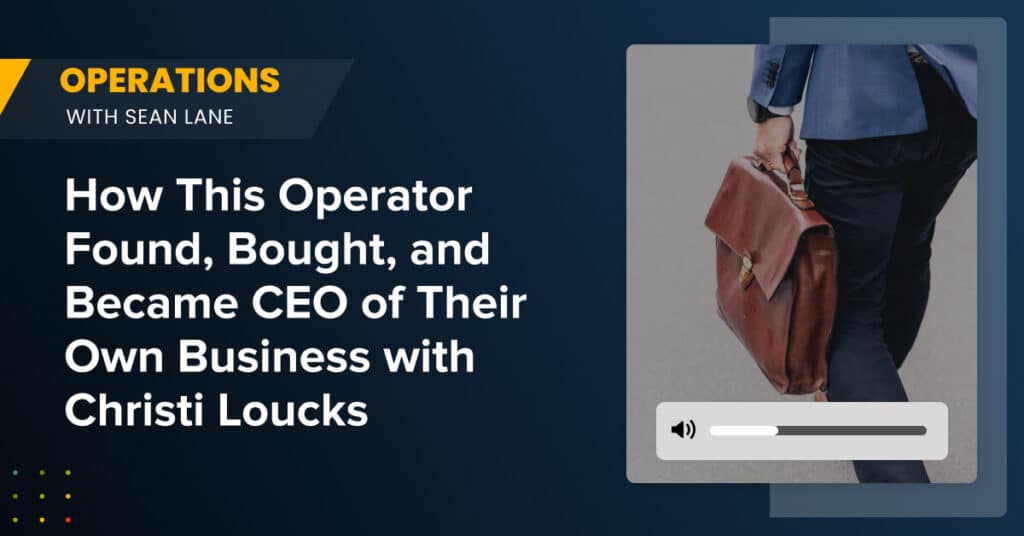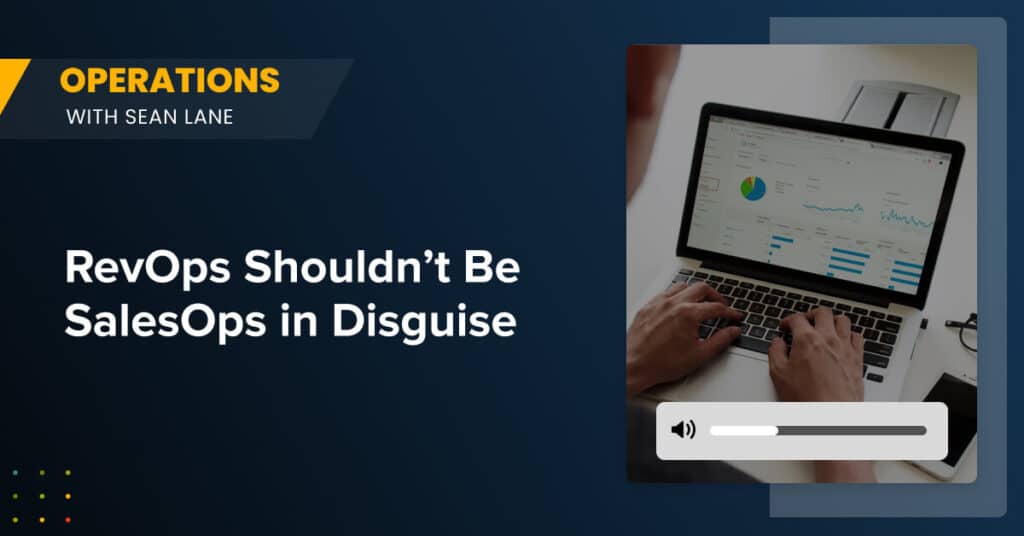Feedback Loops to Fuel the Flywheel of Growth
Overview
- What is a feedback loop? [1:19]
- Examples on classic feedback loops [2:04]
- Feedback loops in RevOps [3:22]
- Determining if something is working or not through feedback loops [4:59]
- Are we always looking at revenue to measure? What else could it be? [7:42]
- Setting up feedback loops to help growth [10:46]
- Defining operational cadence [12:45]
- Where are the gaps and pitfalls? Despite good intentions, why do we sometimes miss? [13:38]
- How to make sure things get communicated [15:08]
- How do you set up your agenda? [16:25]
- Additional things to note in RevOps with feedback loops [17:56]
- Are there any tips and tricks for setting up [19:59]
- How do we prioritize what feedback we focus on? [21:27]
- Example Situation [22:56]
- Final Thoughts + Ending Remarks [25:40]
Introductions
Tyler
Hello, everybody. Welcome to another Fireside chat. Today, we’ll be talking about feedback loops. I’m your host, Tyler Simons. I’m the head of Customer Customer Success at Fullcast. We are a go to market planning and execution platform. Today our guest is Cliff. Cliff, why don’t you go ahead and give us a brief introduction?
Cliff
Sure. Hey, everyone, my name is Cliff Simon. I am the VP of Sales and Revenue for Carabiner Group. We are a full service, fractional, RevOps as a service consultancy. We help folks with things like Salesforce, HubSpot, and pretty much any of the technology that touches those systems. All the way from that entry level tactical work that needs to be done, hands on keyboard, through Fractional VP of RevOps, Fractional CRM. Excited to be here with you.
What is a feedback loop? [1:19]
Tyler
All right, so we’ve had this thread, and you haven’t been on all of our Fireside chats, but we’ve had this theme of feedback loops with multiple guests, and we just keep coming back to it. Then when you and I were chatting before this, we really just honed in on it and you were really excited about it. So I thought we should just spend 30 minutes on feedback loops. So what is a feedback loop?
Cliff
In the most simplest form, a feedback loop is the ability to take feedback or any type of criticism, comments, or knowledge from the clients, from their experience with your product, from their experience with your services, and to bring that back to the varying business teams within your organization to improve upon the things that you could be doing better. To make it a better experience for your clients, to increase your ability to sell, to increase your value propositions and your total adjustable market to make your products better. There’s so many different ways to go into it depending on how you’re taking that feedback and what that feedback is.
Examples on classic feedback loops [2:04]
Tyler
There’s probably a lot of companies that are doing this that don’t know that this is actually a feedback loop. I’m wondering if you can give us some examples in terms of some classic ones. We’re going to get into really thinking about how to create a feedback loop and how to think about that, but maybe there’s some common examples that people recognize. “Yeah, this is a feedback loop that’s already happening, and this is what it looks like.”
Cliff
I think the basic ones are usually like, “Yeah, I’m a customer. I’m using your product. I really wish you had X, Y, or Z feature set or the capability to do this integration. We’d love to see that and if you have that, we’d be willing to pay X amount of dollars more for it because we see the value of that and the time that would save us as a company.” You bring that back to your product team, and now your product team can prioritize and say, “Yeah, okay, how many of our other clients could use something like this? 60% of them? That’s probably worthwhile, especially if there’s an ability to create an additional ARR value around it.
Now you put that into a sprint. Marketing and sales can start testing the water around that as well. Maybe put it in a newsletter, get more information out there, get additional feedback from people in your ICP and your target market. Then now you’ve got that going on in multiple business units. You’re able to drive that forward. Now you’ve got a new feature set that is gonna imply to be more competitive in the marketplace.
Feedback loops in RevOps [3:22]
Tyler
What about in RevOps? I’m trying to think of a good one that exists. I struggle with this because I just don’t think about them that often. So maybe something like in territories where we see a territory performing really well and we kind of take that back. When we maybe break that down into components and see what that is, does that count as a feedback loop?
Cliff
I suppose internally it could. You’re taking a look at the existing data sets, trying to see what’s working. I think folks focus far too often on what’s working and not enough on what’s not working. Like, stop. If it’s not working, stop. If you’re going after a market segment or you’re going after a particular business segment, for example, vertical, and it’s not working, maybe you should either readjust your messaging there and give it a couple more tries. Or you need to go back and double down your money from a marketing and a go-to-market perspective on the things that you know you’re doing really well, and stop trying to be everything to everyone.
You can’t always be a Romans of the Romans. Sometimes you have to focus in on that one area, that niche market that you do really well in and Excel there and just be really good at that one thing. Instead of trying to please every single feature set that’s out there.
Determining if something is working or not through feedback loops [4:59]
Tyler
Let’s double click on the not working piece. Let’s say we’re interested in a certain market. Let’s say financial services, and we’re going to go all in it this year. Are there some things that we should think about in terms of setting up a feedback loop to determine whether something’s working or not? Because, sure, you and I can talk about it and be like, well, we’re not closing deals, so it’s not working. But there’s kind of this nuance of like, well, how much time do we give it? Do we give it two years? Do we give it a year? Is it like pull the plug after two weeks? So I feel like feedback loops can help us determine that nuance and whether to bail out on something or not.
Cliff
If you want to talk about going into a brand new market or a brand new vertical, there’s so many strategies and specificities that you have to look at within that. Is there a pattern there? Do you have competitors in that space that are being successful? Do you understand the industry and the nuances of what they deal with from a business process perspective? What’s driving their industry, what’s driving their issues? Are there regulatory challenges? Are there things that are going on the global supply chain that are adjusting the way that they’re going to market? Is there a language barrier? Is there a cultural barrier? Does a market even exist there, or are you trying to get product market fit?
Because the way you sell your product in EMEA could very well be different than how you sell it here in the US. We see that constantly with companies trying to come across the Atlantic. Or even within the EU. Selling in the Nordics is very different than it is selling in Bellonux. So there’s those aspects to be aware of.
How long do you give the try for? Well, you sure as hell don’t put it into your forecast because you don’t know what’s going to happen. How often does that happen? You have a new product, you’re planning on it coming out in Q3. You’re expecting the second half of Q3 and Q4 to have a huge uptick because you’ve released this new product or this new feature set, and all of a sudden it falls flat on its face. Now you’re scrambling to try to hit a dollar because you put a forecast out there based off this, but you have no idea what it was even going to do.
So insulating yourself and that by not putting that into your forecast and getting an understanding of what’s actually going to be happening there for like a year, year and a half, two years before you actually start pulling that into the total forecast. It sort of has to be its own little mini business unit. It’s a completely different to go to market strategy because you don’t know what it’s going to take to be successful.
Are we always looking at revenue to measure? What else could it be? [7:42]
Tyler
So it’s true. So we break this out. We have a whole different go to market team. It’s like this is on its own. We’re not forecasting for it. Is the number one thing that we’re looking at always revenue? What else could it be?
Cliff
I don’t think it has to just be revenue. There’s a lot of different ways you can measure it. You can start a newsletter and try to make sure that there’s even interest before you commit actual hard resources and finances to this. All the time and effort that it’s going to take to hire a team that’s going to be able to go into that market. Is it worthwhile from a forecasting perspective? Probably not. What kind of resources do you need to put around that? Because as you scale your go to market functions, you need to scale all the operational functions that support it.
Do you have the bandwidth for that? And if those folks are supporting that and it’s not being successful, what does that look like? What are the different volume metrics and conversion rates that you’re going to be looking at for that particular market versus your regular business? How does that stack up? Are there any benchmarks that you can have access to to help you drive that forward so that you know if something’s working? If your typical sale is six months and in this case, a typical sale is eight, that seems feasible. But if your typical sale is a 45 day sale and over here it’s six months, that’s a really different go to market cycle.
So you need to be able to understand throughput what kind of meetings are you getting? Everything on that top of funnel through closing business. Closing business isn’t the end all be all. It’s desirable, but is it the right kind of business?
Tyler
That’s exactly it. You hit on it. Even in the conversion metrics, when you set these things up, as you’re looking at them, you should be leveraging that against what you know is to be true for the rest of the business and making decisions on that. Into your point, if it is a six month or year long sales cycle, and your normal sales cycle is 30, 45 days. Then you know that, “Okay, well, this is a decision point. Maybe we need to build another metric or something to look at to get deeper into that.” Or, “Hey, this is a signal to pull the plug because we’re not interested in waiting twelve months.
Cliff
Yeah. I’ve come from both worlds. I’ve come from SaaS where you’re selling and it’s a 45 or 60 day sales cycle. People are highly motivated. They understand the problems that they have. They’ve got the money in hand because they’ve got tons of VC investment and they have the pressure on them to go and do. On the other side, I’ve sold them to Financial Services, where it’s a 6 to 18 month sales cycle. You have to go through multiple committees and you could get stuck in any one of them.
Then God forbid you’re selling during COVID and now that committee is only meeting once every other month instead of every month. Or they’re not meeting every two weeks like they used to because of constraints of being virtual and all this other stuff. Or maybe they’re going through an audit. There’s so many different factors that play in when you’re going into a new vertical that you have to take all those into account when you plan together your go to market process and understanding what will work.
Setting up feedback loops to help growth [10:46]
Tyler
Yeah. Let’s put the new vertical aside. I mean our whole title for this whole thing was Feedback Loops to Fuel the Flywheel of Growth. It’s kind of a mouthful, but I want to get into setting those up and thinking of, how can we give everyone that’s watching this some action items to think about feedback loops or things to watch to help continue that flywheel. When we think about a flywheel, it just slowly gets faster and faster and faster. The growth, of course, is like a hockey stick.
Cliff
Everyone wants a hockey stick. I’m a hockey player, I know about it. I think the easiest way to do it and the way that works best is creating a solid operational cadence between your different business unit leads and making sure that they’re taking the time to get that information from their team and bring it back to the first team or the executive team or the management team or whatever it might be. So that knowledge is being transferred and that you set that up to be the sacred meeting that you don’t forsake for other reasons.
That operational cadence needs to be continued on a weekly or biweekly basis. Keep that information flowing so that you’re not waiting for a QBR to find out what a customer thinks about something. You’ve got folks that are helping them on a day to day basis in the CS side or the AM side. Get that feedback on a regular basis, put it together in a way that you can accurately ingest it and talk about it, whether that’s in your CRM or I’m sure most people are going to do this in Google sheets, but then that’s fine. But make sure that you’re sharing that data and that there’s a conversation happening around it.
If you’re not collecting it, and you’re not sharing on a regular basis, and I’m not talking once a month. If you’re not sharing on a regular basis, it’s going to hurt because you’re going to be behind the eight ball. You’re never going to be responding. You’re going to be reacting.
Tyler
Can I ask a dumb question?
Cliff
No, you’re good.
Defining operational cadence [12:45]
Tyler
Everyone’s going to laugh at this. What do you mean by operational cadence?
Cliff
So by operational cadence, I mean set meetings on the books that you do not get rid of. That you make sure you are holding true to, because those are the meetings that allow your executive team, your first team from a C suite perspective, your management team for your second line business leaders, to get together to drive the business forward. Everyone wants to talk about getting stuff done, but no one talks about how you actually do it. That’s how you do it. You get in those meetings, you have agendas, you work through it, and now you task orient people to go out and do.
Where are the gaps and pitfalls? Despite good intentions, why do we sometimes miss? [13:38]
Tyler
And that’s kind of closing the loop on a feedback loop, in a sense. That’s probably where most people miss, which is kind of the next thing we wanted to talk about, which is like, where are the gaps in these things and where do I sure we have all these great intentions.
Cliff
It’s the lack of communication. Everyone’s got great intentions. The CSM who had an awesome conversation with the client, took the notes. Did those notes ever leave their notebook? Did they make it into a CRM? Did they make it into an update that was sent to the rest of the team? Did the people who received that update share that information and collate it together and bring it to the larger groups that they can understand about? In the last five months, we’ve probably had 17 clients ask about this one feature. Maybe it makes sense for us to take a look and see if that makes sense.
Or in a better use case, we have clients that are using our product in a way that we didn’t even think it was meant to be used, but it’s been super beneficial for them. How can we take those learnings from that client and turn into a case study for marketing to increase our PAM? Now, I’ve got additional value props that sales can use to go out to the market with, and we can attract more clients, and we can talk to clients about this use case that we didn’t realize people were using our technology for. There’s so many different ways to pull it, but you have to have that communication internally, otherwise it never happens. It’s just living in someone’s brain somewhere as an anecdote that they heard from a client, but it never makes it over to the other parts of the business, and you’re worse off for it.
How to make sure things get communicated [15:08]
Tyler
I mean, we talked about operational cadence, but what are some of the things that we could put in place to make sure that that gets communicated? You probably touched on some of those, but let’s revisit those.
Cliff
Regular meetings, internal newsletters or internal updates about those case studies or those items of interest that you want to bring to everyone’s attention. Like I said, having a set agenda around those items for that operational cadence of the different teams.
For us, we do a weekly call between the sales team and our delivery team. Our operational cadences on the executive team are twice a week so that we never miss stuff. Then we have a larger management team get together at least once a week, and those things always hold true. Sometimes it’s strategic, sometimes it’s tactical, but you’re always sharing the feedback that you’re getting from the client. So that way we can better service them, make sure that they’re getting the right resources, and also better service our future clients to make sure that we’re lining up what we believe we can bring them with the expectations that they’re going to have of us coming in the door.
How do you set up your agenda? [16:25]
Tyler
I know you said agenda, but is it very specific in terms of we are going to cover every week these three things? We’re going to review this and this? Or is there like, do you just kind of show up and talk about what you feel is annoying at this point in time?
Cliff
I think there’s room for both. You have to have those items that you always go over. If you’re talking financially, you’re always going to talk about cash on hand. What’s new in bookings? What’s our actuals? Where are we forecasting out? Same thing in an operational cadence. Where are we on our client renewals? How’s the feedback been? What opinions have the client shared with us that we could be doing better?
Maybe NPS or CSAT gets involved in there somehow, but just making sure that you’re focused on that. Then there’s always going to be time for free form. “Anybody have anything else they want to add? Anything interesting that happened this week?”
Tyler
Just don’t do that at like 3:28 when the meeting is supposed to end at 3:30. You know, it’s going to go on forever.
Cliff
Yeah. I mean, set it up for an hour. You do your first half of the meeting structure, the second half of the meeting on structure and if you finish early, great. Everyone’s got 15 minutes back in their day. But otherwise, maybe you don’t get to it and you don’t have enough space for it. So I’d say at least an hour for that call a week is very useful.
Additional things to note in RevOps with feedback loops [17:56]
Tyler
We got our operational cadence down, our meetings set. What are some other things on the RevOps side that maybe we missed with feedback loops?
Cliff
If you’re getting sophisticated enough, I would love to see that put into CRM. This client gave us this feedback. This client was looking for X amount of feature sets. Now, it’s not just living in a spreadsheet somewhere, but it’s a report I can pull against my different client types, different verticals, and make it a lot easier for you to automate those things and do them in a structured way instead of having it live in a databank.
Tyler
Yeah. It’s basically just making things reportable. But one thing to make things reportable, I think everybody’s got to agree on what that is. Right? You can’t have, “Well, my definition of ARR or my definition of this conversion metric is this. And my definition of it is this.”
Cliff
That’s why you have to have a revenue handbook, right? Have a handbook with all those definitions. What are your exit and entry cards here for different sales stages? What does it look like? All of that needs to be defined.
Tyler
And that’s almost a feedback loop in and of itself. So I’m going to talk a little bit about a mini one. Think about it. You go along, you’ve built this conversion rate, you go into your operational cadence, no one’s agreeing, and then you can see that like, “Okay, well, we have a problem here. No one’s agreed. We’ve got different metrics all over the place. We can’t focus. So now we know that we need feedback to address that in our revenue handbook.” It never ends.
Cliff
Well, yeah. How can it, right? There’s always optimization. There’s always things that are happening within companies. There’s a typical inflection point every three to six months within a SaaS company, there’s always something else to do because you’re always looking for the next growth factor or you’re always trying to strive for that next bit of funding or a future IPO. It never ends. It’s a hamster wheel and we’re all addicted.
Are there any tips and tricks for setting up [19:59]
Tyler
Is there any processes that you’ve had, like tricks or hacks or anything like that, that you’ve used to get these things set up and making sure that they’re running?
Cliff
Getting executive buy in on it, I think is the most important thing. If you can get your CEO or whoever else is in the C suite to agree that these are important, and if they’re being forward thinking about business, they should think these things are important. They’re going to make them a priority. And if you’re leading from the top with that kind of priority, I think you’re going to set yourself up for long term success. That’s the biggest one. You can try as you might from the bottom up, but it becomes a much harder battle to be able to set these things up if you don’t have that executive sponsorship.
Tyler
Yeah, that makes sense.
Cliff
I’ve been on both sides. It’s not fun.
Tyler
I always love to just try to do it from the bottom up and struggle. That’s me. There’s a million of these things that we could put in place. We can go on forever. You can go into Google and type in top KPIs for RevOps teams and the list is probably 700 long.
Cliff
Yeah. They’re usually wrong.
How do we prioritize what feedback we focus on? [21:27]
Tyler
Yeah. They’re still really long. Right. Even if they are. How do we maybe pick the first four or five that we should focus on and kind of gather feedback from? How do we prioritize which ones to look at? Not necessarily the metrics. I kind of just use that as an example. But really any feedback thing that we set up, like how do we prioritize it? Because to your point, we build millions of them.
Cliff
I think it really depends on the business. But the way I would typically prioritize it is by taking a look at what’s going to have the largest effect on the company, either from a churn perspective, if you want to dive down to KPI, how can we decrease churn? How can we increase net dollar retention? I think if you can focus on those two things from a KPI perspective, it helps drive everything else.
I think people tend to celebrate the Series A, Series B, Series C rounds more than they do the actual ARR milestones, which I find to be more impressive. It’s harder to build something than it is to burn through someone else’s money.
I think when you’re focused on building that ARR and doing it in a smart, thoughtful, process-oriented way, that’s something worth celebrating. When that is the focus, it becomes a lot easier to implement things that are going to increase efficiency across that recurring revenue engine.
Example Situation [22:56]
Tyler
I kind of want to get into an example of this. I’m a director of RevOps, coming into a brand new company. There’s basically nothing being set up other than we’re tracking our ARR, but we’re trying to figure out how to get that hockey stick. We’re going to 2X or 3X or whatever it is for this next year. I’ve got to start putting process in place to figure out what lever do I pull or push or whatever you want to do with the lever.
Cliff
The first thing I would do in that particular case is make sure that we have accurate data. If you’re a new VP of RevOps or new director of RevOps and you’re coming into a role, the first 30 days is you sitting back and assessing what’s going on with the different business units. Finding out where things actually stand from a reporting perspective. Is this real or has it been fluffed up?
Then taking that data and putting it into a model where you can actually no longer look at a forecast from a gut feel or this is what these reps say is going to close, but actually taking it from a data driven perspective, saying this has been our historical data over the last 14 months or two or three years, whatever data sets available. Looking at it on a linear regression and pulling that data out to say, “Okay, based off of this curve and what we’ve done historically, this is what we should see in these following months and quarters. Then based off of that now, you could build a real plan that’s data driven.
That’s where I would personally start and then probably hedge my bets a little bit. Maybe it’s not going to be as good as it was in the beginning. It’s harder over time to have exponential growth and compounding growth. You do your 3X, 3X, 2X, 2X, 3. Probably not going to happen. You’ll probably have a 3X year, hopefully another 3X year. Then you’re like one and a half, one and a quarter, 50%, 25%.
It becomes so much more difficult to grow as you get bigger because you’re huge. Unless you’re Salesforce and you’re growing by 26% as a $22 billion revenue company. But at that point, you’re buying companies for the revenue. You’re paying $28 billion so far in slack.
Final Thoughts + Ending Remarks [25:40]
Tyler
That’s why I laughed, because you just buy another company and I got all this growth. We’re almost there to our mark here. Are we missing anything? Is there anything else that you want to share with us that maybe I forgot about or we haven’t talked about?
Cliff
I think RevOps is still this unique thing where everyone’s still figuring it out or they’re seeing everyone else doing it and they feel like they have to do it now. It doesn’t have to be all encompassing right away, but you need to start somewhere and feedback loops is a great way to do it.
Start by listening and putting together a team that can work across all of your business units and that’s the start of it. How can you make sure that you’re using a smart, well allocated resource across your entire business to elevate it? How can you make that feedback loop part of this rising tide that raises the bar for everyone?
Tyler
Yeah, for me it’s operational cadence. I got to go do this on my side.
Cliff
I’ve got a whole deck for you if you want it.
Tyler
Yeah I’d love it. Cliff, thank you so much, really appreciate you taking the time and until next time.
Cliff
Yeah, awesome. Really great to chat with you and if anyone has any questions that they want to follow up on, feel free to reach out to me. It’s cliff@carabinergroup.com or you can find me on LinkedIn.
Tyler
Great. See you Cliff.
Cliff
Thanks everyone. Bye.










